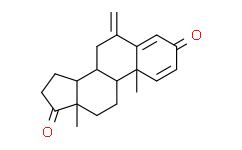| Cas No.: | 107868-30-4 |
| Chemical Name: | Exemestane |
| Synonyms: | 6-Methylene-androsta-1,4-diene-3,17-dione;6-methylenandrosta-1,4-diene-3,17-dione;6-METHYLENEANDROSTA-1,4-DIENE-3,17-DIONE;10,13-dimethyl-6-methylidene-7,8,9,10,11,12,13,14,15,16-decahydrocyclopenta[a]phenanthrene-;EXEMESTANE;FCE-24304;AROMASIN;EXEMESTANCE;ExeMestane(AroMasin);Anti-Estrogen AI Exemestaneknightlabs_leeisun;6-methylenandrost-1,4-diene-3,17-dione;androsta-1,4-diene-6-methylene-3,17-dione;CE24304;EXALAMIDE;EXE;Exemestan;ExemestaneF;FCE 24304;PNU155971;ExeMestine;Exemestane D2;ExeMestane (USP);Exemestanum;Exemestano;Exemestanum [INN-Latin];Exemestano [INN-Spanish];Exemestane [USAN:INN:BAN];FCE24304;Aromasine;NY22HMQ4BX |
| SMILES: | O=C1C=C2[C@@](C=C1)(C)[C@@H]3[C@@H](CC2=C)[C@H]4[C@@](CC3)(C)C(=O)CC4 |
| Formula: | C20H24O2 |
| M.Wt: | 296.4034 |
| Purity: | >98% |
| Sotrage: | 2 years -20°C Powder, 2 weeks 4°C in DMSO, 6 months -80°C in DMSO |
| Description: | Exemestane(FCE 24304) is an aromatase inhibitor, inhibits human placental and rat ovarian aromatase with IC50 of 30 nM and 40 nM, respectively.October 2005Exemestane competitively inhibits and time-dependently inactivates of human placental aromatase with Ki of 4.3 nM. Exemestane displaces [3H]DHT from rat prostate androgen receptor with IC50 of 0.9 μM [1]. Exemestane (1 μM) increases alkaline phosphatase activity in hFOB and Saos-2 cells and induces the expression of MYBL2, OSTM1, HOXD11, ADCYAP1R1, and glypican 2 in hFOB cells [2]. Exemestane causes aromatase degradation in a dose-responsive manner in MCF-7aro cells [3].Exemestane increases lumbar spine BMD by 14.0% in OVX rats at dose of 100 mg/kg. Exemestane (100 mg/kg) and 17-hydroexemestane (20 mg/kg) significantly reduces an ovariectomy-induced increase in serum pyridinoline and serum osteocalcin in rats and causes significant reductions of serum cholesterol and low-density lipoprotein cholesterol inOVX rats [4].Exemestane (20 mg/kg/day s.c.) induces 26% complete (CR) and 18% partial (PR) tumor regressions in rats with 7,12-dimethylbenzanthracene (DMBA)-induced mammary tumors [5]. |
| Target: | Aromatase |
| References: | [1]. Di Salle, E., et al., Novel aromatase and 5 alpha-reductase inhibitors. J Steroid Biochem Mol Biol, 1994. 49(4-6): p. 289-94. [2]. Miki, Y., et al., Effects of aromatase inhibitors on human osteoblast and osteoblast-like cells: a possible androgenic bone protective effects induced by exemestane. Bone, 2007. 40(4): p. 876-87. [3]. Wang, X. and S. Chen, Aromatase destabilizer: novel action of exemestane, a food and drug administration-approved aromatase inhibitor. Cancer Res, 2006. 66(21): p. 10281-6. [4]. Goss, P.E., et al., Effects of the steroidal aromatase inhibitor exemestane and the nonsteroidal aromatase inhibitor letrozole on bone and lipid metabolism in ovariectomized rats. Clin Cancer Res, 2004. 10(17): p. 5717-23. [5]. Zaccheo, T., D. Giudici, and E. Di Salle, Inhibitory effect of combined treatment with the aromatase inhibitor exemestane and tamoxifen on DMBA-induced mammary tumors in rats. J Steroid Biochem Mol Biol, 1993. 44(4-6): p. 677-80. |

 DC Chemicals' products qualify for U.S. tariff exemptions. We guarantee no price increases due to customs duties and maintain stable supply, continuing to deliver reliable research solutions to our American clients.
DC Chemicals' products qualify for U.S. tariff exemptions. We guarantee no price increases due to customs duties and maintain stable supply, continuing to deliver reliable research solutions to our American clients.





















